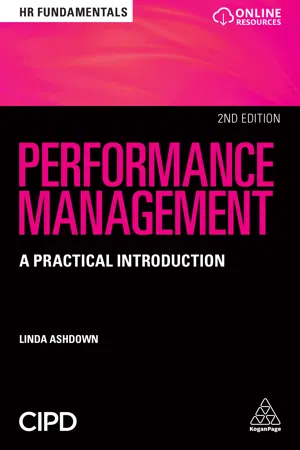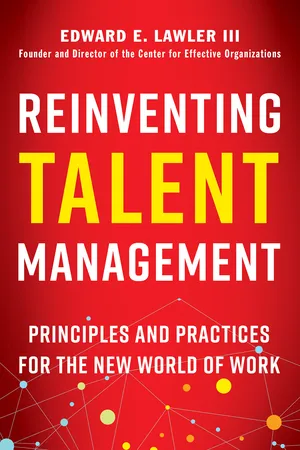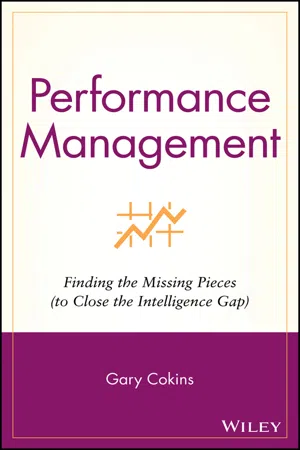Business
Performance Management
Performance management involves the process of setting goals, assessing progress, and providing feedback to employees to improve their performance. It encompasses regular performance evaluations, coaching, and development planning to ensure that employees are meeting organizational objectives and continuously improving their skills and capabilities. Effective performance management contributes to overall business success by aligning individual performance with organizational goals.
Written by Perlego with AI-assistance
Related key terms
1 of 5
11 Key excerpts on "Performance Management"
- eBook - ePub
Performance Management
A Practical Introduction
- Linda Ashdown(Author)
- 2018(Publication Date)
- Kogan Page(Publisher)
Performance Management is made up of many activities that when managed holistically can lead to effective people management. The particular challenge of providing a clear, comprehensive definition of Performance Management is that it covers such a breadth of activities. It is also difficult to define precisely as the nature of Performance Management will and should vary according to the organization context. The sector, structure, size, culture, strategy and leadership of the organization will all influence the nature of Performance Management. One of the most often used definitions is that of Armstrong (2009): ‘Performance Management is a systematic process for improving organizational performance by developing the performance of individuals and teams.’ One of the reasons this definition has proved so popular is because at its heart is the crucial issue of the link between the performance of an organization’s human resources and the achievement of organization goals. ‘Alignment’ is a key ingredient in successful Performance Management systems: the alignment of an individual’s performance to the goals of the organization.A senior director I worked with in the advertising industry once told me that he regarded effective Performance Management as having an invisible thread linking the organization’s mission statement to the performance objectives of the individual – and that image has stayed with me both in my practice as an HR professional and when teaching human resource management (HRM) to others. I firmly believe that the core principle of everyone working for an organization having a clear understanding of how they contribute to the mission, vision and goals of the organization is an important one. There is a real benefit to the organization of having all the people who work for it focused on the right things to add value. There are also clear benefits for the employees of that invisible thread being in place. For example, the intrinsic satisfaction of feeling significant, understanding their contribution and ultimately feeling valued by the organization – that invisible thread helps to deliver that understanding and those feelings. This is a powerful enabler for retaining staff and supporting them to deliver high-performance outcomes. Individuals are much more likely to ‘go the extra mile’ for those organizations where they understand and value the organization’s goals and believe that they can contribute to the achievement of those goals and will be valued for doing so. Unfortunately, in many organizations that connection between the organization’s goals and individual contribution is either weak or missing altogether; this has the potential to impact detrimentally on both the performance of the individual and that of the organization. - eBook - ePub
People Practice
A Complete Guide
- Karen Waite, Kathy Beevers, Nicky Small, Keith Tomlinson, Shazad Hussain(Authors)
- 2021(Publication Date)
- CIPD - Kogan Page(Publisher)
Performance Management could be said to be about doing the right things as well as doing things right. It is about ensuring that employee efforts are focused on activities that will fulfil organisational goals, and that those activities are carried out to the required standard.This, and all the benefits listed above, would be considered desirable by most organisations and their employees, and so it is not difficult to understand why almost all organisations attempt to implement some form of Performance Management system.Meanings and definitions
Performance Management
The term ‘Performance Management’ is used in a number of different ways, often depending on people’s experience of it. Consequently, for some, ‘Performance Management’ is an overarching term which covers the full spectrum of people management, from induction through to allocating work, agreeing performance objectives, monitoring work, informing reward decisions, managing poor performance and recognising high performance. However, for those at the other end of the scale, ‘Performance Management’ can simply refer to an annual appraisal event.In many ways, Performance Management has evolved from an earlier management approach known as ‘management by objectives’ (MBO). MBO, popularised by a number of management gurus, most notably Peter Drucker (1954) and John Humble (1972) has an emphasis on goal setting and ensuring that goals are firmly aligned across the whole organisation. Organisation goals are cascaded downwards into team objectives, which in turn cascade into individual performance objectives. Performance is then closely monitored and measured, with individual performance outcomes feeding back up into team outcomes and ultimately into the achievement of organisational goals.While MBO promoted worker agreement and some ownership of objectives, the tight management controls involved conflicted with the gradual shift towards greater worker autonomy and self-regulation. The approach was also sometimes criticised for taking insufficient account of the different factors, other than worker performance, that can affect the extent to which organisational goals are achieved. - eBook - PDF
- Scott Snell, Shad Morris(Authors)
- 2018(Publication Date)
- Cengage Learning EMEA(Publisher)
279 CHAPTER 8 Performance Management Learning Outcomes After studying this chapter, you should be able to Explain what Performance Management is and how the establishment of goals, ongoing performance feedback, and the evaluation process are part of it. Describe the different sources of performance-management information. LO 1 LO 2 Explain the various methods used to evaluate the performance of employees. Outline the characteristics of effective performance review meetings and feedback sessions and ways in which the performance of employees can be improved. LO 3 LO 4 wavebreakmedia/Shutterstock Copyright 2019 Cengage Learning. All Rights Reserved. May not be copied, scanned, or duplicated, in whole or in part. Due to electronic rights, some third party content may be suppressed from the eBook and/or eChapter(s). Editorial review has deemed that any suppressed content does not materially affect the overall learning experience. Cengage Learning reserves the right to remove additional content at any time if subsequent rights restrictions require it. 280 Part 3 Developing Effectiveness in Human Resources 8.1 Performance Management Systems We have discussed some of the ways that you as a manager can acquire top-notch employees and train and develop them. But how do you know if your efforts are really paying off in terms of what the employees are contributing once they are on the job? Performance Management is the process of creating a work environment in which people can perform to the best of their abilities in order to meet a company’s goals. It is an entire work system that flows from a company’s goals. Figure 8.1 shows the elements of a Performance Management process. Performance reviews are the result of a process by which a manager evaluates an employee’s performance relative to the requirements of his or her job, the goals set with his or her manager, and then uses the information to show the person where improvements can be made and how. - eBook - PDF
- Joao Heitor De Avila Santos(Author)
- 2020(Publication Date)
- Society Publishing(Publisher)
The Performance Management process begins with the addition of a new person to the team and ends when the employee leaves the company. Quality management can be seen as a systemic mechanism by which the overall performance of a company can be increased by improving the performance of individuals within a team structure. It is a way of encouraging superior performance through the communication of objectives, the identification of roles within the necessary skill framework, and the development of attainable benchmarks. The word Performance Management gained popularity in the early 1980s when overall quality control systems were given the utmost importance for the pursuit of superior expectations and quality performance. Tools such as job design, leadership development, and training and reward systems have received equal momentum, along with the traditional performance assessment process, in a new, comprehensive, and much broader framework. Performance Management is a continuous process of contact between managers and workers throughout the year. The mechanism is very cyclical and constant. The Performance Management program shall include the following actions. • Create specific job descriptions and employee performance plans, including key performance areas (KRA’s) and perfor-mance indicators. • Select the right set of people by implementing an appropriate Organizational Performance Measures and Management in Organizations 211 selection process. • Negotiate criteria and performance standards for calculating production and allocative efficiency against predefined bench -marks. • Supply continuous coaching and feedback during the success delivery cycle. • Identify preparation and development needs by assessing the outcomes obtained against the established standards and imple-menting appropriate performance implementation programs. • Hold quarterly performance development conversations and as-sessing employee performance based on performance plans. - eBook - ePub
Managing People
A Practical Guide for Front-line Managers
- Rosemary Thomson, Eileen Arney, Andrew Thomson(Authors)
- 2015(Publication Date)
- Routledge(Publisher)
• It is strongly associated with development and especially identifying what development is needed.At one level Performance Management is strategic in that it is concerned with integrating the different dimensions of an organisation’s operations into its wider objectives, but it is also concerned with the role of the individual manager and, indeed, expects responsibility to be shared by all members of the organisation. The integration is primarily vertical, aligning organisational, team and individual objectives, but can also be functional, bringing together functional strategies in different parts of the organisation and within functions, such as integrating different aspects of managing people.The aim of Performance Management is continuously to improve the performance of individuals and that of the organisation. It involves making sure that the performance of employees contributes to the goals of their teams and the business as a whole. The system is operated on an annual cycle which evaluates the past, sets future objectives, plans for the development needed to achieve those objectives, and potentially links to a framework of rewards, whilst there is also an ongoing record of progress and constant feedback on performance. This annual cycle is central to the whole concept of Performance Management, which has four distinct stages, although the review and the plan stages are usually carried out at the same time through the appraisal system, whilst the develop and perform stages are carried out continuously throughout the year. - eBook - PDF
- Surbhi Jain(Author)
- 2020(Publication Date)
- Society Publishing(Publisher)
Figure 1.1. Goals of Performance Management. Source: Saylord Blog. Performance Management frameworks are designed with the objective of improving both individual and organizational performance by identifying Performance & Compensation Management 4 performance requirements, providing regular feedback and assisting the employees in their career development (Berthon et al., 2009; Haworth and Hughes, 2015). Figure 1.1 highlights the goals of a Performance Management framework.At the more sophisticated level, the Performance Management framework will help to construct a culture that is supportive of the goals and objectives of the organization (Hennigs et al., 2013; Kasperk et al., 2011). Operating at the micro, meso, and macro level, the Performance Management framework can transform the entire niche or sector (Hunter and Katz, 2012; Kay et al., 1994). By allowing people to take responsibility for their work, this type of approach can increase the commitment and engagement of the people that are responsible for operational success (Ibrahim and Zailani, 2010; Kerzner, 2003). Business processes are then clearly defined in terms of how they contribute to the strategic goals of the organization (Ifinedo, 2016; Klikauer, 2014). The goals can eventually be broken down into very specific objectives that can guide teams and individuals as they do their work (Ismail et al., 2005; Lock, 2007). In an effort to live up to the standards that are laid out by the Performance Management framework, employees can engage in various activities such as training which helps them to develop their competencies within the field (Johnson and Clark, 2008; Loorbach, 2010). For some, this is a form of incentive that justifies the effort that they have to put into the process of building their contribution to the strategic objectives of the organization within which they operate (Jurevicius, 2016; Lycett et al., 2004). - eBook - PDF
Performance Management
A New Approach for Driving Business Results
- Elaine D. Pulakos(Author)
- 2009(Publication Date)
- Wiley-Blackwell(Publisher)
This helps ensure that employees are treated in a fair and equitable manner, which is especially important when Performance Management is used for decision-making. Before discussing each step in detail, there are some important caveats about the process to recognize. It is: Targeted to individuals, not teams • While team performance is critical in many organizations, the pre- dominant need and vast majority of Performance Management systems provide evaluations of individuals, which are required for decision-making and development. Thus, although there are needs for team-based Performance Management in some contexts, these will not be addressed here. Most relevant for non-executives • While many of the same principles discussed in this book apply to executive Performance Management, there are unique aspects of executive evaluation that are beyond the scope of this book. 37 38 How to Design a Successful Performance Management Process Not sufficient for handling disciplinary issues or serious perfor- mance problems • While the Performance Management approach discussed here helps identify employees who are performing below standards, most organizations initiate a separate process with employees who con- sistently fail to meet standards. This involves putting employees on a formal performance improvement plan or opportunity period, where their specific deficiencies are documented, needed improve- ments are specified in detail, and timelines are provided within which performance targets must be met. Initiating formal oppor- tunity periods is serious and is often a precursor to performance- based terminations. Although significant and consequential, this process falls outside of typical Performance Management activities and will not be treated in depth here. Figure 4.1 The Performance Management process Performance Management Process Step 4. Employees provide input on own perceptions of performance Step 3. Managers and employees hold ongoing performance discussions Step 7. - eBook - ePub
Effective People Management
Your Guide to Boosting Performance, Managing Conflict and Becoming a Great Leader in Your Start Up
- Pat Wellington(Author)
- 2017(Publication Date)
- Kogan Page(Publisher)
07Performance Management
Introduction
Performance Management is helping a member of your staff understand their role and responsibilities, and their individual contribution to realizing business objectives through achieving planned and agreed results. Many organizations also use Performance Management in career planning and personal development.What does a member of staff expect from their manager?- Where the team and individuals are headed. This is the business vision.
- Why they are headed there (and not somewhere else). This is the business mission or why the organization exists.
- What it looks like when they get there. How our objectives and efforts help us to deliver the organization’s mission and business plans.
- How we should behave and work together as a team. This is all about the organization’s culture.
So if you are recruiting someone into your team, jointly agree with them what you expect (and do not expect from them) in terms of performance and behaviours. This is where key results areas (KRA) and targets are required.Key results areas flow from individual or team job descriptions. KRAs contribute towards clarifying how we should (as a team) be spending our time . For the team’s strategy to succeed all team members must achieve specific results, which when accumulated, ensure that all strategy elements are delivered. KRAs are a summary of those key factors of an individual’s job or the team’s job that are vital for the team’s success. They must be monitored, at a minimum, each month to ensure keeping on track with your strategy.If you have difficulty identifying your KRAs ask yourself the following question: ‘What are the major aspects of the team’s work that could go wrong?’ You might say ‘We don’t realize our sales target’, ‘We use up our resources’, ‘Too many customers complain’ or ‘We don’t complete our reports on time’. These can be translated into the following KRAs – sales, finance, customer service and monthly reports. - eBook - ePub
Reinventing Talent Management
Principles and Practics for the New World of Work
- Edward E Lawler(Author)
- 2023(Publication Date)
- Berrett-Koehler Publishers(Publisher)
The key to decisions with respect to what the right behaviors are to measure and what segments to create should primarily be driven by what is measureable and how frequently and in what way the key organizational outcomes can be measured. To some degree this will be determined by the activity that is being examined and by the hierarchical level that is the focus of Performance Management activities. Also important are the skills of managers and the kind of technology that can be utilized.Performance Management judgments and evaluations need to become much more data-and evidence-based. Data also need to be gathered on how effective an organization’s appraisal systems are, on what is working and what is not working, and on how well individuals are actually carrying out the appraisal process. The Performance Management process is too important a process to be left to chance; it needs to be based on evidence of effectiveness and supported by an ongoing measurement system that focuses on how it is being implemented and is impacting performance.Overall, Performance Management is an area that requires major changes to be effective in the workplace of the future. It has not been effective in the past, and it is only going to be less effective if the same practices that have been used for decades continue to be used. A thoughtful data-based Performance Management system is badly needed in most organizations. Given the technology and knowledge that is currently available, it is possible that effective Performance Management systems can be designed and utilized by organizations. Because of the nature of the current workplace and workforce, Performance Management has never been more important than it is today, and it has never been so possible to do it effectively. - eBook - PDF
Managing Employee Performance and Reward
Concepts, Practices, Strategies
- John Shields, Michelle Brown, Sarah Kaine, Catherine Dolle-Samuel, Andrea North-Samardzic, Peter McLean, Robyn Johns, Patrick O'Leary, Geoff Plimmer, Jack Robinson(Authors)
- 2015(Publication Date)
- Cambridge University Press(Publisher)
77 Part 2 Performance Management in action The three chapters in part 2 examine the key concepts, techniques and processes as- sociated with the management of employee performance. In chapter 1 we observed that, from a descriptive ‘cybernetic’ (i.e. systems) perspective, work performance may be thought of as having three horizontal or process dimensions – that is, inputs (knowledge, skills and abilities), task effort and other types of work behaviour, and outcomes or results; and three vertical or scalar dimensions – that is, individual, group and organisation-wide performance. By definition, the methods that accentu- ate behaviour and competency have an individual focus. Chapters 4 and 5 examine the main Performance Management methods or tech- niques associated with each of these dimensions. Chapter 4 considers those ap- proaches to Performance Management that are results-focused. Chapter 5 will then consider the methods and techniques that are behaviourally focused and examine the concepts and techniques that emphasise performance inputs or capacities in the form of performance competencies. Chapter 6, the final chapter in part 2, examines both the provision of performance feedback to individual employees and practices directed towards performance development, including coaching. 78 4 Managing for results John Shields and Andrea North-Samardzic Results are the most tangible and readily measurable of the horizontal dimensions of performance, so we shall begin our discussion at the end, as it were, by examining in this chapter those approaches to Performance Management that are results-focused, including both those that focus on individual results and those that are associated with group and organisation-wide results. The chapter begins with an overview of those facets of work performance that are commonly characterised as ‘results’. - eBook - PDF
Performance Management
Finding the Missing Pieces (to Close the Intelligence Gap)
- Gary Cokins(Author)
- 2004(Publication Date)
- Wiley(Publisher)
The con- cept of context is important. It elevates this methodology well above manage- ment by objectives (MBO) and spreadsheet performance reports. Performance Management PROCESS WHEEL IN ACTION Focus, communication, and collaborate—iteratively. It does work. This is not theory but rather a proven methodology supported by commercial software technology. 3 66 STRATEGY MAPS AND BALANCED SCORECARDS Scorecard Software Systems: Technology Is No Longer the Impediment Organizations can fine-tune the selection of their measures with an ongoing scorecard system that allows the flexibility to remove, add, substitute, and re- configure how the key performance indicators (KPIs) relate to strategies. Un- fortunately, most organizations are usually so preoccupied with trying to steer the organizational ship through the high seas, they have not implemented the platform—the navigational system and compass—to facilitate steerage, let alone fine-tuning. Despite huge investments in time (and perhaps in consultants) to define the corporate strategy, the executive team typically asks a young spreadsheet whiz in the accounting department to automate it all. This usually results in an overly complex and incomprehensible set of disconnected scorecards that are difficult to maintain and update, and, worse yet, problematic to adjust for new strategies. This defeats the benefits of effective learning, communica- tions, and feedback. Commercial strategy mapping and scorecard software solves this problem. In complex environments, it is no simple task to identify owners of strate- gic objectives, to select the correct measures, to give each measure the right level of emphasis for balance, to assign a reasonable level of performance, and then to monitor the results. In the past, to complicate matters, there was little in software technology to support this methodology that links dependent performance measurements.
Index pages curate the most relevant extracts from our library of academic textbooks. They’ve been created using an in-house natural language model (NLM), each adding context and meaning to key research topics.










